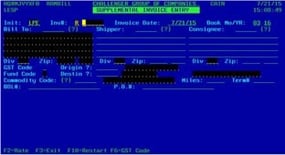By Eden Watt, Vice President, Application Innovation, Able-One Systems
If there’s one common challenge that I hear repeatedly from IT leaders that I meet, it’s how to integrate and merge disparate applications, especially after acquisitions or line of business changes.
The complexity of systems managed by many organizations today can be mind boggling. This happens over many years of technology maturation, especially as the organization adds new products and services, or additional business units are added through mergers and acquisitions. Rather than acquiring new software to meet the comprehensive and evolving needs of the organization, this typically involves extending the original software or working with multiple software applications for different business areas and stitching them together.
Gartner has coined the term “Postmodern ERP” to be a “more federated, loosely coupled ERP environment with much (or even all) of the functionality sourced as cloud services or via business process outsourcers”. This growing trend indicates that the days of purchasing one monolithic ERP package to service all the processing needs of the business is coming to an end. Applications that have served the business well over many years do not necessarily need to be replaced as organizations start to embrace new cloud and mobile technologies as they expand their capabilities.
Case Study: Challenger, a Transportation & Logistics Company
The approach Challenger has taken to address their growing business is a great example of how to achieve this with the least amount of disruption to the business.

In business for 40 years, Challenger is one of Canada’s largest privately held trucking fleets offering transportation, logistics, warehousing and distribution services. With their traditional business model, Challenger started with an RPG-based software package as their Transportation Management System (TMS) from Innovative Computer Corp (ICC) and Infinium for financials. They have knowledgeable in-house developers to maintain these applications which have been stable and finely tuned to their needs for many years, especially in the FTL area of their business.
However, the Challenger business has grown significantly both organically and through acquisitions and they now offer complete supply chain including truckload, LTL, LCV and small parcel transport services, 3pl and 4pl support, intermodal, container shipping, air freight and ocean freight cargo shipping internationally.
To service logistics and other business areas, Challenger uses cloud-based Mercury Gate which allows customers to sign into TMS and provides more customer-facing capabilities. However, their financial systems and LTL business are still handled on premise with IBM i based Infinium and ICC. In order to manage the flow of invoice information between the two systems, Challenger’s invoicing department has been rekeying information between the two systems on a daily basis.
Recently, Challenger acquired looksoftware’s soarchitect to develop web services integration to address manual procedures for integration between their on premise and cloud-based systems. This tool is unique in that you can target the RPG-based screens to create a web services layer, reducing the need to rewrite or duplicate complex logic for interfacing with legacy systems.
After a short learning curve, Les Peebles from Challenger has been able to very quickly introduce automation in two key areas for the invoicing team which is saving them considerable time and reduction of errors.

He expects to continue to improve the processing power within Challenger using soarchitect which has gotten rave reviews from both the users and IT.
According to Les, he says: “I thoroughly enjoyed working with the tool and our users have thoroughly enjoyed the result. An added benefit,” he says, “is that the RPG programmers also feel comfortable with it because instead of writing a new web service that could circumvent their application, this is a technology enhancer instead of a replacer.”
The key to meeting the challenges of the “postmodern” world is to reuse, extend, and integrate rather than complete replacement because by the time you implement full-scale ERP replacement strategies, the world will have changed again.
Are you looking to integrate and merge disparate applications, but need help? Contact us for a free consultation.
